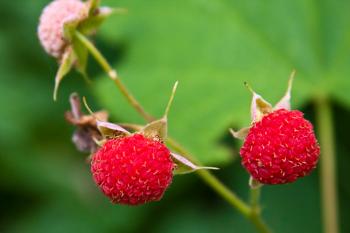Thimbleberry
Common Name
Thimbleberry, Snow Bramble
Scientific Name
Rubus parviflorus
First Nations Name(s)
Upriver Halkomelem Name(s): t'qwum (fruit), t'qwumulhp (shrub)
Downriver Halkomelem Name(s): t'qwum (fruit), t'qwumulhp (shrub)
Island Halkomelem Name(s): t'uqwum (fruit
Family
Rosaceae (rose family)
Identification
Thimbleberry is a deciduous shrub that can grow 0.5 - 3m high. Thimbleberries themselves are smaller than a raspberry, red when ripe and are most often sweet depending on location and preference. Flowers are the biggest of the Rubus genus and are white, have five petals, are slightly crinkled with a flattened yellow centre where the fruit grows. The leaves of the thimbleberry are 3-7 lobed resembling a maple leaf shape with a green top and slightly white underneath. These leaves have a soft fuzzy touch to each side, a feature only the thimbleberry has in the Rubus genus and are 10-20cm across. Stems are thornless with a fine fuzz when young and turn greyish and flakey with age.
Cautions
Avoidance of consumption if pregnant
Excessive consumption can have adverse side effects
Current Distribution and Habitat
The Thimbleberries current distribution is widespread through western North America reaching from Alaska down to the Mountain ranges of New Mexico. Thimbleberry is also found as east to the Great Lakes in Canada. This shrub prefers open, cool, moist sites with lower elevations. It can tolerate mild drought and is typically most avid in disturbed sites with a forest canopy.
Location on University of Victoria
Thimbleberry exists at UVIC in a small patch by West Campus Way
( see map below )
Ethnobotanical Uses
Thimbleberry has been used for both its medicinal and nutritional uses. The berries themselves are an excellent source of vitamins c while also containing fibre and carbohydrates. They are often eaten fresh or dried and mixed with other berries to be made into cakes and added to smoked clams. The leaves of Thimbleberry can be boiled and made into a tea for stomach complaints (including nausea, diarrhea, dysentery and more…), used as an appetizer and a herbal bath for skin and hair. The leaves can also be dried and crushed to be made into a poultice to prevent scarring of burns as well as to treat acne and other oily skin issues. The shoots of Thimbleberry are eaten raw or cooked as a vegetable.
Other facts:
-Wide leaves can be used as a gathering cup if folded
-Leaves also known as “nature wipes” because of its softness
-In order to help the navels of babies heal it is possible to burn stem galls and rub the ashes on the area.
View presentation on Thimbleberries ethnobotanical uses and how to make astringent face toner here.
Written by Oona-Vaughn Murray-Dyde
References
Gucker, C. (2012). Rubus parviflorus. Retrieved from https://www.fs.fed.us/database/feis/plants/shrub/rubpar/all.html
Healthbenefitstimes. (2017). Thimbleberry-Rubus parviflorus. Retrieved from https://www.healthbenefitstimes.com/thimbleberry/nggallery/thumbnails.
Florin, M.(March 8, 2017). Rubus parviflorus(Thimbleberry). Retrieved from https://www.cabi.org/isc/datasheet/48013
Turner, N.J., Thompson, L.C., Thompson, M.T., & York, A.Z. (1996). Thompson Ethnobotany: Knowledge and Usage of Plants by the Thompson Indians of British Columbia. Victoria, BC: Royal British Columbia Museum
http://nativeplantspnw.com/thimbleberry-rubus-parviflorus/
Image References:
Healthbenefitstimes. (2017). Leaves-of-Thimbleberry-Thimbleberry-Thimbleberry-close-up-flowe-Thimbleberry-flower-buds-Thimbleberry-seedlings-Thimbleberry-unripe-fruitRetrieved from https://www.healthbenefitstimes.com/thimbleberry/nggallery/thumbnails
Project Status:
Year:
Associated Projects:
Image:

